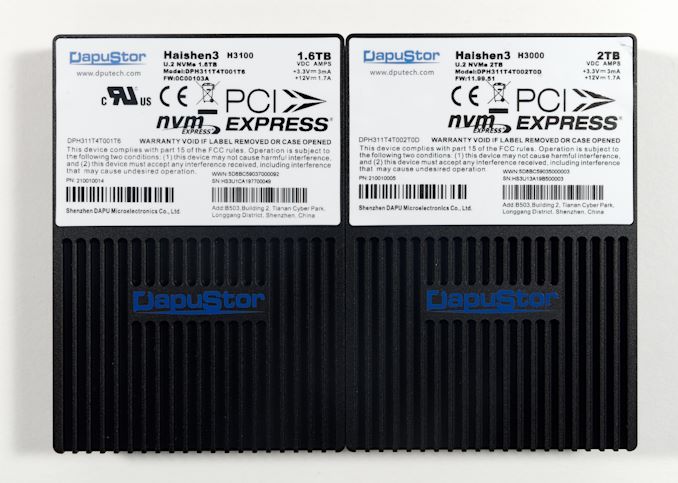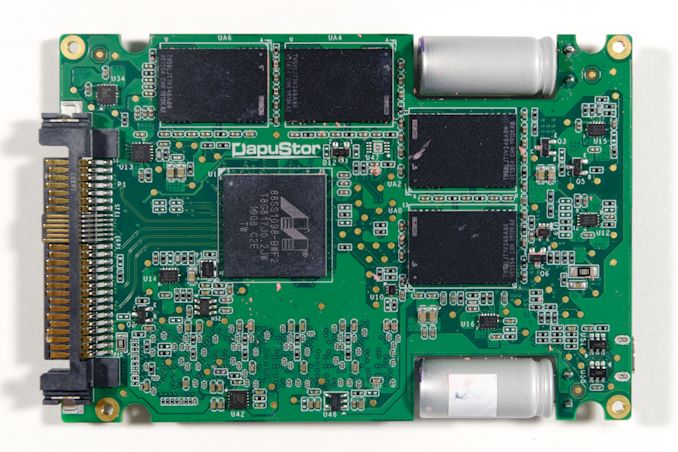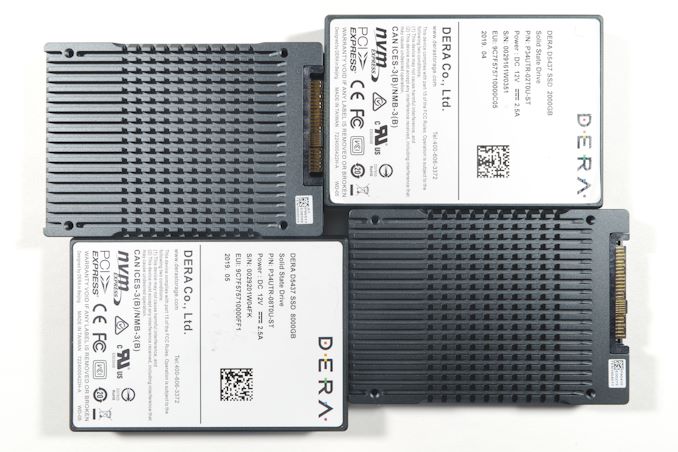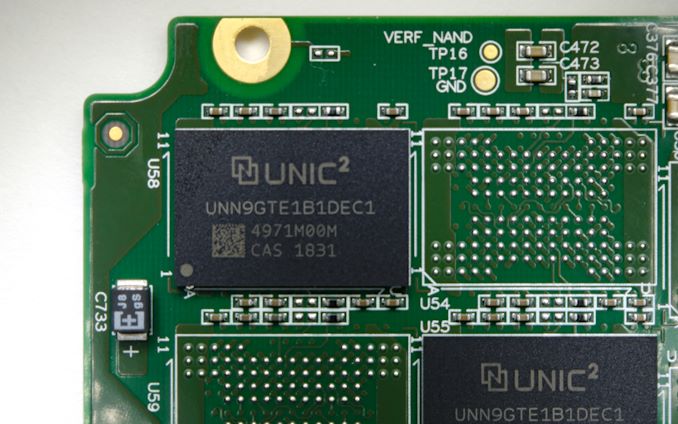Enterprise NVMe Round-Up 2: SK Hynix, Samsung, DapuStor and DERA
by Billy Tallis on February 14, 2020 11:15 AM ESTDapuStor Haishen3
Shenzhen DAPU Microelectronics Co.—DapuStor for short— has a fairly ordinary business model for a smaller player in the enterprise SSD market: partner with a controller supplier and a NAND supplier, and write some custom firmware. In the case of the DapuStor Haishen3 series, the controller comes from Marvell and the NAND is from Kioxia (formerly Toshiba Memory).
The DapuStor Haishen3 drives use Kioxia/Toshiba BiCS4 96-layer 3D eTLC, the most advanced NAND flash included in this review. We're testing both the H3000 and H3100 versions: 1 DWPD for read-intensive workloads, or 3 DWPD for more write-heavy mixed IO. DapuStor touts the power efficiency of the Haishen3 drives as one of the key selling points. As far as advanced features, the drives include support for multiple NVMe namespaces, and dual-port PCIe support for high availability when connected through appropriate backplanes. DapuStor is also willing to supply custom firmware enabling other advanced features like SR-IOV virtualization, streams/IO determinism, and Key-Value or Zoned namespace support. However, it's not clear how ready those options are—the Haishen3 is a very new product, and our samples were slightly delayed so that we could get the latest firmware.
| DapuStor Haishen3 Series Specifications | ||||||||||||
| Model | H3000 | H3100 | ||||||||||
| Controller | Marvell 88SS1098 Zao | |||||||||||
| Form Factor | 2.5" 15mm U.2, HHHL AIC |
HHHL AIC |
2.5" 15mm U.2, HHHL AIC |
HHHL AIC |
||||||||
| Interface, Protocol | PCIe 3.0 x4 NVMe 1.3 | |||||||||||
| Capacities (TB) | 1 | 2 | 4 | 8 | 16 | 0.8 | 1.6 | 3.2 | 6.4 | 12.8 | ||
| NAND Flash | Kioxia (Toshiba) 512Gbit BiCS4 96L 3D TLC | |||||||||||
| DRAM | Nanya 8Gbit DDR4-2666 | |||||||||||
| Sequential Read (GB/s) | 3.5 | 3.5 | ||||||||||
| Sequential Write (GB/s) | 1.3 | 2.4 | 3.3 | 3.4 | 1.3 | 2.4 | 3.3 | 3.4 | ||||
| Random Read IOPS | 450k | 710k | 450k | 710k | ||||||||
| Random Write IOPS | 38k | 60k | 108k | 99k | 140k | 98k | 170k | 335k | 300k | 465k | ||
| Power Draw (Watts) |
Typical | 6.5 | 8.5 | 6.5 | 8.5 | |||||||
| Max | 9.5 | 13 | 15 | 9.5 | 13 | 15 | ||||||
| Write Endurance | 1 DWPD | 3 DWPD | ||||||||||
| Warranty | 5 years | |||||||||||
The Marvell 88SS1098 "Zao" controller is their 8-channel solution for enterprise/datacenter SSDs, bringing lots of features that were missing from the 1093/1092 "Eldora" series controllers and left out of the newer 1100 series client SSD controllers. The 1098 isn't quite Marvell's top of the line SSD controller, but their 88SS1088 16-channel controller is a two-chip solution that's pretty much two 1098s connected by a 4GB/s link.
Our Haishen3 review samples use the 15mm U.2 form factor, but only have a single PCB internally instead of two staked. That makes the case a fairly large heatsink, with extrusions to allow close contact to the controller and NAND, and cutouts for the two large power loss protection capacitors.
DapuStor is also working on a Haishen3-XL series that uses Kioxia's low-latency 3D SLC NAND to compete against Samsung Z-SSDs, and that should be available very soon.
DERA D5007 Series
DERA is another Chinese brand we were only recently introduced to. They announced their second generation of enterprise SSDs at the end of 2018 and are now trying to enter the North American market after securing design wins with numerous major Chinese cloud and telecom providers.
DERA is part of China's efforts to develop competitive home-grown technology. DERA has their own in-house TAI NVMe SSD controller that is used in the D5437 and D5457 SSDs we are testing today. Their NAND supplier is UNIC, which has been buying Intel 64L wafers since 2018 and doing their own testing, binning and packaging. UNIC eventually plans to be a distributor for Yangtze Memory's 3D NAND, but even though YMTC announced mass production of their 64L NAND back in November, they have not had any significant impact on the NAND market yet. (And probably won't any time soon, given that YMTC is based in Wuhan.) For DRAM, DERA is using Micron DDR3.
| DERA D5007 Series Specifications | ||||||||
| Model | D5437 | D5457 | ||||||
| Controller | DERA TAI-EN316801-P02 | |||||||
| Form Factor | 2.5" 15mm U.2 or PCIe HHHL AIC | |||||||
| Interface, Protocol | PCIe 3.0 x4 NVMe 1.3 | |||||||
| Capacities | 2 TB | 4 TB | 8 TB | 1.6 TB | 3.2 TB | 6.4 TB | ||
| NAND Flash | UNIC2 (Intel) 512Gbit 64L 3D TLC | |||||||
| DRAM | Micron DDR3-1866 | |||||||
| Sequential Read (GB/s) | 3.3 | 3.3 | ||||||
| Sequential Write (GB/s) | 1.8 | 2.9 | 3.2 | 1.8 | 2.9 | 3.2 | ||
| Random Read IOPS | 820k | 830k | 830k | 820k | 830k | 830k | ||
| Random Write IOPS | 110k | 160k | 145k | 240k | 360k | 375k | ||
| Power Draw (Watts) |
Random Read | 13.0 | 14.0 | 14.5 | 13.5 | 13.5 | 14.5 | |
| Random Write | 15.0 | 18.0 | 18.4 | 15.0 | 18.5 | 20.0 | ||
| Idle | 7.0 | |||||||
| Write Endurance | 1 DWPD | 3 DWPD | ||||||
| Warranty | 5 years | |||||||
As is typical, DERA's SSDs come in two versions that share the same basic hardware but use different overprovisioning ratios to optimize for high capacity and read-oriented workloads (D5437), or higher endurance and better write performance (D5457). These drives have most of the hallmarks of a top of the line enterprise SSD. The controller is a large 16-channel design, with a die size around 114 mm2. Internally, the U.2 versions use a folded PCB to provide plenty of space for NAND and DRAM, and the power loss protection capacitors are mounted on a daughterboard. The case design does allow for a little bit of airflow between the two PCB layers, but the power-hungry stuff still needs to be facing outward for contact with the drive case. The NAND packages on the inward-facing PCB surfaces use fewer dies per package, and when a particular capacity doesn't need to populate all of the pads for NAND, those interior spots are the ones left empty.
The DERA SSDs are limited to by the same PCIe 3.0 x4 interface as the rest of our U.2 drives, but the performance specifications are otherwise mostly higher than the other drives in this review—as are the power consumption ratings.
























33 Comments
View All Comments
Billy Tallis - Friday, February 14, 2020 - link
Me, too. It's a pity that we'll probably never see the Micron X100 out in the open, but I'm hopeful about Intel Alder Stream.I do find it interesting how Optane doesn't even come close to offering the highest throughput (sequential reads or writes or random reads), but its performance varies so little with workload that it excels in all the corner cases where flash fails.
curufinwewins - Friday, February 14, 2020 - link
Absolutely. It's so completely counter to the reliance on massive parallelization and over provisioning/cache to hide the inherent weaknesses of flash that I just can't help but being excited about what is actually possible with it.extide - Friday, February 14, 2020 - link
And honestly most of those corner cases are far more important/common in real world workloads. Mixed read/write, and low QD random reads are hugely important and in those two metrics it annihilates the rest of the drives.PandaBear - Friday, February 14, 2020 - link
Throughput has alot to do with how many dies you can run in parallel, and since optane has a much lower density (therefore more expensive and lower capacity), they don't have as many dies on the same drive, and that's why peak throughput will not be similar to the monsters out there with 128-256 dies on the same drive. They make it back in other spec of course, and therefore demand a premium for that.swarm3d - Monday, February 17, 2020 - link
Sequential read/write speed is highly overrated. Random reads and writes make up the majority of a typical workload for most people, though sequential reads will benefit things like game load times and possibly video edit rendering (if processing isn't a bottleneck, which is usually is).Put another way, if sequential read/write speed was important, tape drives would probably be the dominant storage tech by now.
PandaBear - Friday, February 14, 2020 - link
Some info from the industry is that AWS is internally designing their own SSD and the 2nd generation is based off the same Zao architecture and 96 layer Kioxia NAND that DapuStor makes. For this reason it is likely that it will be a baseline benchmark for most ESSD out there (i.e. you have to be better than that or we can make it cheaper). Samsung is always going to be the powerhouse because they can afford to make a massive controller with so much more circuits that would be too expensive for others. SK Hynix's strategy is to make an expensive controller so they can make money back from the NAND. Dera and DapuStor will likely only focus in China and Africa like their Huawei pal. Micron has a bad reputation as an ESSD vendor and they ended up firing their whole Tidal System team after Sanjay joined, and Sanjay pouched a bunch of WD/SanDisk people to rebuild the whole group from ground up.eek2121 - Friday, February 14, 2020 - link
I wish higher capacity SSDs were available for consumers. Yes, there are only a small minority of us, but I would gladly purchase a high performance 16TB SSD.I suspect the m.2 form factor is imperfect for high density solid state storage, however. Between heat issues (my 2 TB 970 EVO has hit 88C in rare cases...with a heatsink. My other 960 EVO without a heatsink has gotten even hotter.) and the lack of physical space for NAND, we will likely have to come up with another solution if capacities are to go up.
Billy Tallis - Friday, February 14, 2020 - link
Going beyond M.2 for the sake of higher capacity consumer storage would only happen if it becomes significantly cheaper to make SSDs with more than 64 NAND dies, which is currently 4TB for TLC. Per-die capacity is going up slowly over time, but fast enough to keep up with consumer storage needs. In order for the consumer market to shift toward drives with way more than 64 NAND dies, we would need to see per-wafer costs drop dramatically, and that's just not going to happen.Hul8 - Saturday, February 15, 2020 - link
I think the number of consumers both interested in 6GB+ *and* able to afford them are so few, SSD manufacturers figure they can just go buy enterprise stuff.Hul8 - Saturday, February 15, 2020 - link
*6TB+, obviously... :-D